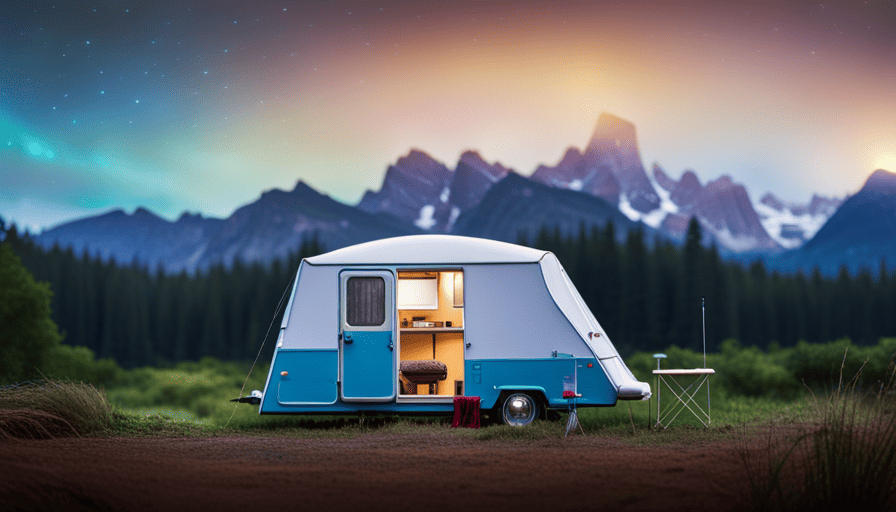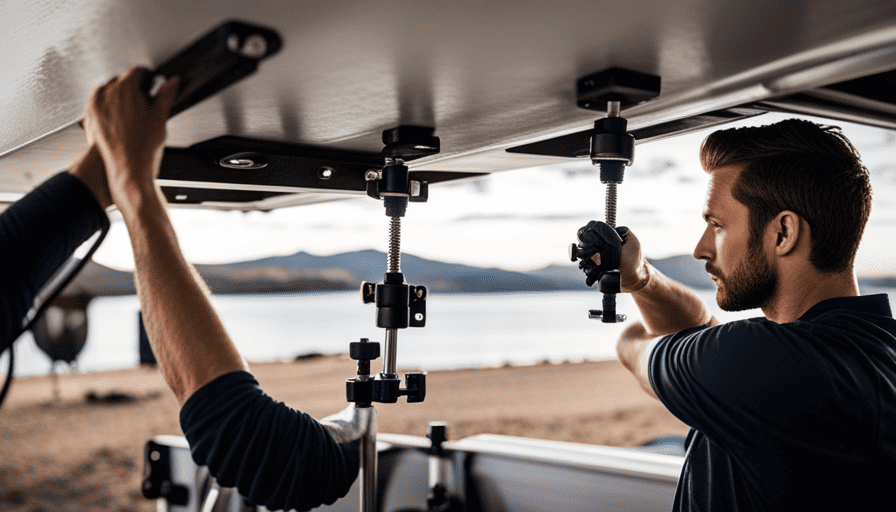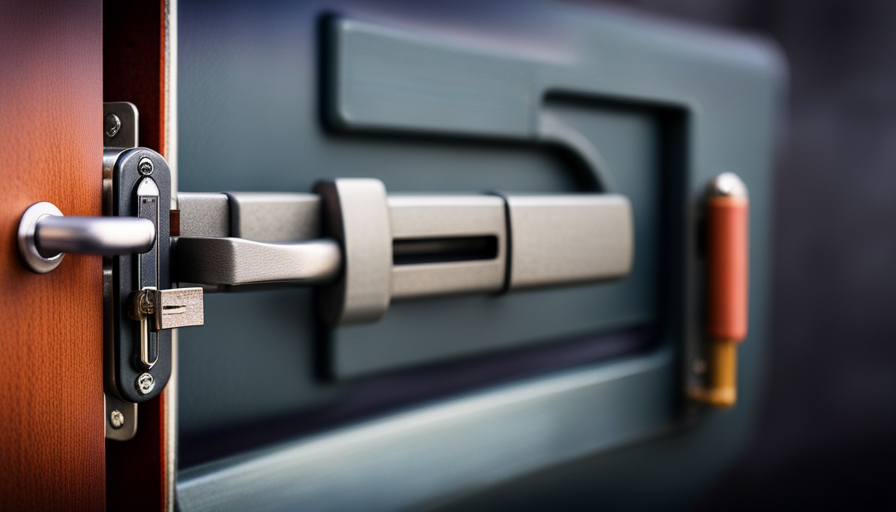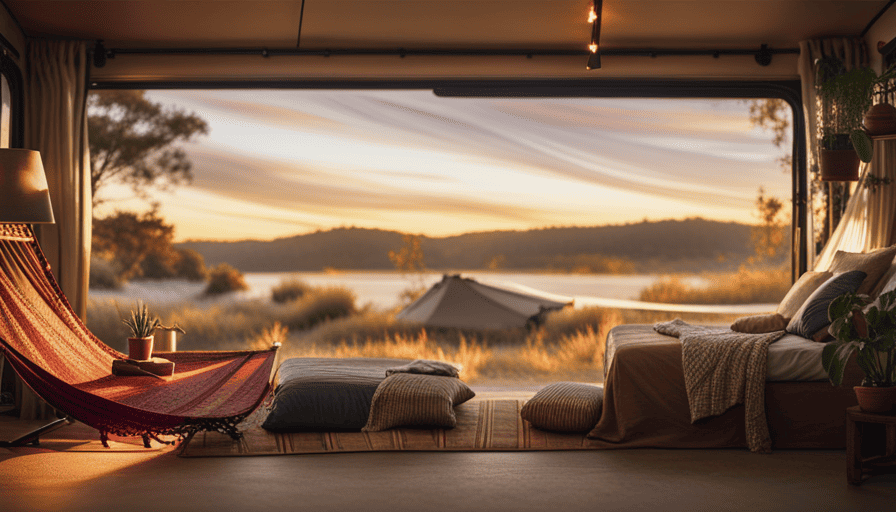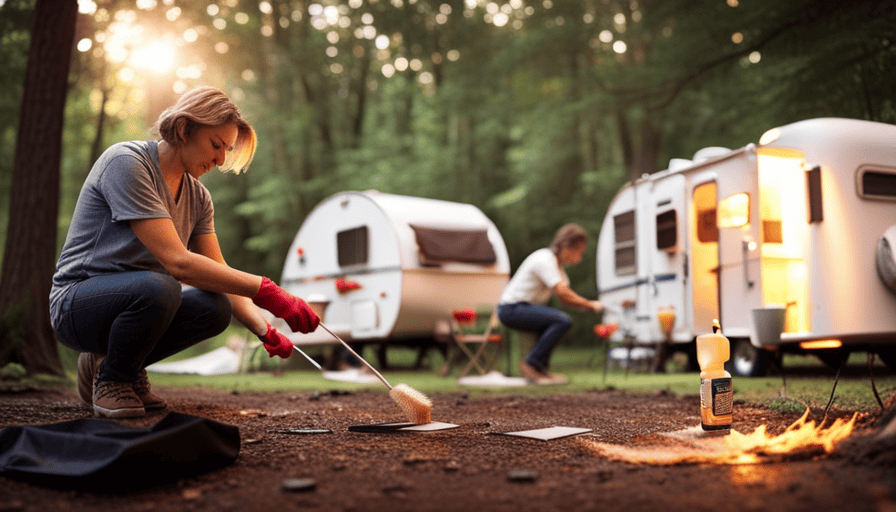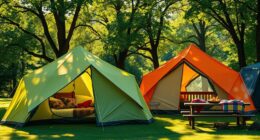Ever gone camping and found it challenging to hang items in your camper? Worry no more, fellow explorer! I present to you an extensive guide on hanging techniques in a camper, making sure your area stays tidy and practical.
Imagine the convenience of effortlessly hanging your favorite photos, artwork, or even a mirror to add a touch of home to your mobile abode. With a little planning and the right tools, you can transform your camper into a cozy sanctuary on wheels.
In this article, I will walk you through the process of:
- Assessing the structure of your camper
- Choosing the appropriate hanging hardware
- Measuring and marking the placement
- Preparing the surface for installation
We will then delve into the specifics of:
- Hanging medium weight items
- Hanging mirrors or shelves
- Securely hanging heavy items
Finally, we will discuss testing and adjusting to ensure everything is secure and stays in place during your travels.
So, let’s dive in and learn how to make your camper a hanging haven!
Key Takeaways
- Assess the structure and stability of the camper before hanging anything.
- Choose lightweight and durable hanging hardware that is appropriate for the camper materials.
- Use adhesive hooks as a temporary solution for lightweight items.
- Utilize tension rods for curtains or dividers to create separate spaces in the camper.
Assess the Structure of Your Camper
Now, let’s take a moment to assess the structure of your camper so you can confidently hang things without worrying about damaging anything.
Assessing the stability of your camper is crucial before hanging anything. Start by examining the walls and ceiling to identify any weak spots. Look for any signs of damage or areas that might not be able to support the weight of the items you want to hang. Reinforcing weak spots is essential to prevent any accidents or damage. You can use adhesive hooks or brackets to add extra support where needed.
Next, consider the type of material your camper is made of. Different materials may require different hanging techniques. For example, if you have a fiberglass camper, you may need to use different hardware than if you have a wooden camper. Take note of any manufacturer recommendations regarding hanging items on your camper’s walls or ceiling.
By assessing the structure and stability of your camper, you can ensure that you choose the right hanging hardware. This will help you avoid any potential damage and allow you to hang things securely.
Choose the Right Hanging Hardware
When it comes to choosing the right hanging hardware for my camper, I always go for lightweight and durable options. They need to be able to withstand the constant movement and vibrations while still holding up whatever I hang on them.
For temporary solutions, adhesive hooks are a lifesaver. They’re easy to install and remove without leaving any damage behind.
And when it comes to curtains or dividers, tension rods are the way to go. They’re versatile, adjustable, and provide a secure grip, ensuring my privacy and creating separate spaces in my camper.
Select lightweight and durable options
For a camper, it’s essential to choose hanging options that are both lightweight and durable, so they don’t weigh down the walls while withstanding the bumpy roads. When it comes to lightweight storage solutions, there are a few key factors to consider. First, opt for materials like plastic or aluminum instead of heavy metals. Second, look for hooks and hangers that are specifically designed for RVs, as they are often made with lighter materials. Lastly, consider the weight of the items you plan to hang and choose hooks that can support them without causing damage. To emphasize this point, here’s a table showcasing different lightweight hanging options:
| Hanging Option | Material | Weight Capacity |
|---|---|---|
| Plastic hooks | Plastic | Up to 1 lb |
| Aluminum hangers | Aluminum | Up to 5 lbs |
| Bungee cords | Elastic | Up to 10 lbs |
When it comes to choosing the right hooks, lightweight and durable options are key. However, it’s also important to consider adhesive hooks for temporary solutions. These hooks provide a convenient way to hang items without the need for drilling or permanent fixtures.
Consider adhesive hooks for temporary solutions
If you’re looking for a convenient and temporary way to attach items to your RV walls, adhesive hooks can be a great solution. With over 90% of campers finding them easy to use and reliable, adhesive hooks have become a popular choice for hanging pictures and other lightweight items in a camper. They offer a hassle-free installation process, as they simply stick to the wall without the need for drilling or hardware. Plus, they can easily be removed without leaving any residue behind.
When using adhesive hooks for pictures, keep in mind their weight capacity and choose hooks that can support the size and weight of your frames. As an alternative hanging option, adhesive hooks provide a versatile and practical solution for camper organization.
Now, let’s move on to the next section about using tension rods for curtains or dividers.
Use tension rods for curtains or dividers
To maximize the functionality and aesthetics of your RV space, consider utilizing tension rods to effortlessly create curtains or dividers. Tension rods are a versatile and practical solution for dividing spaces in a camper, and they can be used in various creative ways. For example, you can hang a tension rod horizontally near the ceiling to create a makeshift closet or storage area. Additionally, tension rods can be used to create a separate sleeping area by hanging curtains or privacy screens.
To give you some discussion ideas, here are a few alternative uses for tension rods in a camper:
- Hang a tension rod near the kitchen area to hang utensils or small pots and pans.
- Use tension rods in the bathroom to hang towels or create a shower curtain rod.
- Hang a tension rod near the entrance to create a mini mudroom for shoes and jackets.
- Create a makeshift bookshelf by placing tension rods horizontally and using them to support books or magazines.
By thinking outside the box, you can find countless creative ways to divide and organize your camper using tension rods. Now, let’s move on to the next section and discuss how to measure and mark the placement for your tension rods.
Measure and Mark the Placement
Get ready to bring your camper to life by measuring and marking the perfect spots for hanging decorations.
The first step is to assess the structural integrity of the walls and ceiling. You don’t want to hang anything heavy on weak spots that could potentially damage your camper. Once you’ve determined the sturdy areas, it’s time to choose the right hanging hardware. Depending on the weight and type of decor you plan to hang, you might need different types of hooks, adhesive strips, or screws. Consider using lightweight options like adhesive hooks for small decorations and tension rods for curtains or dividers.
To ensure accurate placement, measure the height and width of the wall or ceiling space where you want to hang your decor. Use a tape measure to mark the exact spots where the hardware will go. It’s a good idea to use a level to make sure everything is straight. Once you have marked the spots, double-check the measurements to avoid any mistakes.
Now that you’ve measured and marked the perfect spots, it’s time to move on to preparing the surface. This involves cleaning the area where the hardware will be placed to ensure a strong and secure attachment.
Prepare the Surface
Before I can start hanging anything in my camper, I need to prepare the surface properly.
First, I’ll clean the area using a mild cleaner to ensure it’s free from any grime or grease.
Next, I’ll remove any dirt or debris that might be stuck to the surface, making sure it’s completely clean.
Lastly, I’ll allow the surface to dry completely before proceeding, as a wet surface can affect the adhesion of any hooks or hangers I plan to use.
Clean the area with a mild cleaner
First, grab a rag and some soapy water to give the area a good scrubbing. Cleaning the surface before hanging things in a camper is crucial for a successful installation. Using a mild cleaner has several benefits. Firstly, it helps remove any dirt or debris that could interfere with the adhesion of the hanging materials. Additionally, a mild cleaner is less likely to damage the surface compared to harsh chemicals. This ensures that the camper remains in good condition. When cleaning, it’s important to avoid common mistakes such as using abrasive cleaners that can scratch the surface or leaving behind residue that could affect the adhesion. By taking the time to properly clean the area, you’ll create a clean and smooth surface, making it easier to hang things securely. So, let’s move on to the next step and remove any dirt or debris.
Remove any dirt or debris
To properly prepare the area, make sure you thoroughly clean any dirt or debris. Cleaning tips are essential to create a clean and organized space in your camper. Begin by using a mild cleaner to wipe down the surface, removing any dust or grime. Pay attention to corners and crevices where dirt can accumulate. Use a soft cloth or sponge to gently scrub the area, being careful not to damage any surfaces.
Organizing ideas can also come into play here, as you can use this opportunity to declutter and remove any unnecessary items. Once you’ve cleaned the area, allow the surface to dry completely before moving on to the next step. This will ensure that any adhesive or hanging methods you use will adhere properly.
Allow the surface to dry completely
After removing any dirt or debris from the surface, it’s important to allow it to dry completely before proceeding. This step is crucial because hanging things on a wet or damp surface can lead to damage or even mold growth. So, take your time and make sure the surface is thoroughly dry before moving on to the next step.
To ensure a successful hanging experience in your camper, here are five things to consider:
- Select the appropriate hanging hardware: Choosing the right hooks or clips will ensure a secure and long-lasting hold.
- Allow for proper ventilation: Adequate airflow around the hanging items will prevent moisture build-up and maintain a fresh environment.
- Consider the weight: Make sure the hanging hardware can support the weight of the item you want to hang.
- Positioning: Determine the best location for hanging based on aesthetics and functionality.
- Double-check: Before installing the hanging hardware, double-check your measurements and ensure everything is aligned correctly.
Now that the surface is dry and ready, let’s move on to the next step of installing the hanging hardware.
Install the Hanging Hardware
Now that you’re ready to jazz up your camper, let’s dive into the fun part – putting up the hanging hardware! When it comes to hanging things in a camper, there are different types of hanging hardware available for specific needs. It’s important to choose the right hardware based on the weight and size of the item you want to hang. Here are some discussion ideas for selecting the perfect hanging hardware:
| Hardware Type | Best for | Tips for Preventing Damage |
|---|---|---|
| Adhesive Hooks | Lightweight items like hats, towels, or small decorations | Make sure to clean the surface before applying the hook and avoid hanging heavy items. |
| Tension Rods | Curtains or shower curtains | Measure the space accurately to ensure a snug fit and avoid putting excessive weight on the rod. |
| Screw-in Hooks | Heavy items like mirrors or artwork | Use a stud finder to locate a strong point on the wall and be careful not to overtighten the screws. |
To prevent damage to your camper’s structure, it’s essential to follow a few tips. Firstly, avoid drilling into walls or cabinets unless absolutely necessary. Instead, utilize existing hooks or install temporary hooks that can be easily removed without leaving marks. Secondly, use caution when hanging heavy items and distribute the weight evenly to avoid putting too much strain on the walls.
Now that you know how to install the hanging hardware, let’s move on to the next section about how to hang lightweight items without causing any damage.
Hang Lightweight Items
When it comes to hanging lightweight items in a camper, I’ve found a few handy tricks.
For small frames or decorations, I love using adhesive hooks. They’re easy to install and remove, and they hold securely without leaving any marks on the walls.
If you have small metal items like kitchen utensils or magnetic spice containers, magnetic strips are a great option. They’re strong enough to hold the items securely, and they’re easy to reposition if needed.
Lastly, for lightweight decor such as paper lanterns or fabric banners, I highly recommend using removable adhesive putty. It’s versatile, easy to use, and it won’t damage the walls or leave any residue behind.
Use adhesive hooks for small frames or decorations
To easily hang small frames or decorations in a camper, consider using adhesive hooks. These handy hooks are a game-changer when it comes to alternative hanging methods in tight spaces. The benefits of using adhesive hooks in a camper are numerous. First, they are incredibly easy to install and remove without causing any damage to the walls. Secondly, they provide a secure hold, ensuring that your frames or decorations stay in place even when you’re on the move. Additionally, adhesive hooks are versatile and can hold a surprising amount of weight, despite their small size.
To give you an idea of their capabilities, here’s a comparison table:
| Traditional Hooks | Adhesive Hooks |
|---|---|
| Require drilling and hardware | Easy peel-and-stick installation |
| May cause damage to walls | Leave no residue or damage |
| Limited weight capacity | Can hold up to X pounds |
With adhesive hooks, you can easily hang small frames or decorations in your camper, making it feel like a cozy home on wheels. However, if you have small metal items to hang, consider magnetic strips as an alternative.
Consider magnetic strips for small metal items
If you’re looking to add a touch of charm to your mobile abode, magnetic strips can discreetly display your small metal treasures. They’re not only practical, but they also add a unique aesthetic to your camper.
One great use for magnetic strips is in the kitchen, where you can easily store and access your metal utensils. No more rummaging through drawers or searching for that elusive spatula!
Additionally, magnetic strips are perfect for organizing and keeping track of your tools. Whether you’re a DIY enthusiast or just need a reliable set of tools for occasional repairs, having them within reach and neatly organized is essential. With magnetic strips, you can easily attach your tools to any metallic surface in your camper.
So say goodbye to clutter and hello to an organized and stylish living space.
Now, let’s move on to using removable adhesive putty for lightweight decor…
Use removable adhesive putty for lightweight decor
Transform your mobile abode into a stylish and personalized space with the use of removable adhesive putty for lightweight decor. This versatile and easy-to-use alternative to traditional nails and screws allows you to add a pop of color or a touch of whimsy to your camper without causing any damage.
Here are four tips for using removable adhesive putty in small spaces:
- Hang lightweight artwork or posters on the walls to create a cozy atmosphere.
- Use it to secure small mirrors or picture frames on cabinet doors for a touch of elegance.
- Stick decorative hooks on the inside of cabinets or closets to hang lightweight accessories like hats or jewelry.
- Attach small shelves to the walls to display collectibles or plants.
With these removable adhesive putty alternatives, you can easily transform your camper into a personalized oasis.
Now, let’s move on to hanging medium weight items and explore more creative ways to decorate your space.
Hang Medium Weight Items
First, you’ll need to gather some adhesive hooks to hang medium weight items in your camper, such as a small hanging mirror on the bathroom door. When hanging medium weight items, it’s important to take safety precautions to ensure that the hooks are secure and won’t damage the walls or doors of your camper.
Start by cleaning the surface where you plan to hang the item with rubbing alcohol to remove any dirt or grease. This will help the adhesive hooks adhere better and provide a stronger hold.
Next, choose the right size and weight capacity of adhesive hooks for your specific item. Make sure to read the package instructions to determine the weight limit of each hook.
To hang the medium weight item, simply peel off the backing of the adhesive hook and press it firmly onto the desired surface. Hold it in place for a few seconds to ensure a good bond. Once the hook is secure, you can hang your mirror or other medium weight item on it.
Now that you know how to hang medium weight items, let’s move on to how to hang mirrors or shelves in your camper.
Hang Mirrors or Shelves
To add a touch of elegance and functionality to your camper, consider hanging mirrors or shelves. Not only can they make your space feel larger and more open, but they also provide a convenient place to store and display your belongings.
Hanging plants can add a touch of greenery and freshness to your camper, creating a cozy and inviting atmosphere.
When it comes to organizing storage, shelves are a great option. They allow you to maximize vertical space and keep your belongings neatly organized. You can use them to store books, kitchen items, or even decorative pieces that bring personality to your camper.
Mirrors, on the other hand, can make your camper feel more spacious and bright. They reflect light and create the illusion of a larger space. They can also be functional, allowing you to check your outfit or get ready for the day.
By incorporating mirrors or shelves into your camper, you can create a stylish and functional living space.
Now, let’s move on to how to securely hang heavy items without causing any damage to your camper.
Securely Hang Heavy Items
One way to add style and functionality to your camper is by securely hanging heavy items. Here are three tips to help you hang heavy items in your camper:
-
Use sturdy hooks or brackets: When hanging heavy items like plants or shelves, it’s important to use strong hooks or brackets that can support the weight. Look for hooks that are specifically designed for heavy-duty use and can be securely fastened to the walls or ceiling of your camper.
-
Distribute the weight evenly: To ensure that your camper remains stable while on the move, it’s important to distribute the weight of the heavy items evenly. Avoid hanging all the heavy items on one side of the camper, as this can affect the balance and cause instability while driving.
-
Hang clothes efficiently: If you’re looking to hang heavy clothing items like coats or jackets, consider using multi-purpose hangers that have built-in hooks or clips. This will allow you to securely hang your clothes while maximizing space in your camper.
By securely hanging heavy items in your camper, you can add both style and functionality to your space. Once you’ve hung your items, it’s always a good idea to test and adjust their placement to ensure they’re secure and won’t move during travel.
Test and Adjust
As I embark on the journey of securing my camper, I remember that just like a captain adjusts the sails to navigate the open sea, testing and adjusting the placement of my heavy items ensures a smooth and stable ride.
It’s crucial to test the effectiveness of how I hang things in my camper, especially when it comes to heavy items.
After securely hanging my heavy items, I take the time to test their stability. I gently push and pull on each item to see if it moves or feels loose. If I notice any instability, I make adjustments to the placement. This may involve repositioning the hooks or straps, or adding additional support to ensure everything stays in place.
I also consider the weight distribution inside the camper. If I find that the heavy items are causing the camper to tilt or become unbalanced, I make further adjustments. This might mean redistributing the weight or adding counterweights to maintain stability on the road.
By continuously testing and adjusting the placement of my heavy items, I can rest assured that my camper will remain secure and stable throughout my journey. It’s all about finding that perfect balance to ensure a safe and enjoyable experience on the open road.
Frequently Asked Questions
How do I assess the structure of my camper to determine the best spots for hanging things?
To assess the structure of my camper and find the best spots for hanging things, I first consider the weight capacity of different areas. I check the walls, ceiling, and even the furniture for sturdiness. If the walls are too thin, I look for alternative hanging spots like hooks on the back of doors or adhesive hooks on cabinets.
I also make sure to distribute the weight evenly to avoid any potential damage. Being thorough and practical ensures a secure and organized camper.
What type of hanging hardware should I choose for hanging items in my camper?
When it comes to hanging items in my camper, I’ve discovered some alternative hanging methods that have saved me from the dreaded task of drilling holes. Adhesive hooks are a game-changer, allowing me to hang things without damaging the walls.
However, for heavier items, screw-in hooks are the way to go.
As for delicate or breakable items, I’ve learned to use soft fabric or foam padding to protect them during bumpy rides.
It’s all about finding the right balance between functionality and style in my mini home on wheels.
How do I properly measure and mark the placement for hanging items in my camper?
Proper measurement techniques and accurate marking are essential when hanging items in my camper. To ensure precision, I start by using a tape measure to measure the desired placement. I take into account the weight and size of the item to determine the appropriate hanging method.
Then, I mark the spot with a pencil or masking tape. This helps me visualize the final position and make any adjustments before securing the hardware. Following these steps ensures a sturdy and aesthetically pleasing display in my camper.
What steps should I follow to prepare the surface before installing the hanging hardware?
Before installing hanging hardware in a camper, it’s crucial to properly clean the surface. To do this, I recommend using mild soap and warm water to remove any dirt or grime. For tougher stains, a gentle cleaner like vinegar or baking soda can be effective. It’s important to avoid harsh chemicals that could damage the surface.
Additionally, if you’re looking for alternative ways to hang items without traditional hardware, adhesive hooks or tension rods can be great options.
How do I securely hang heavy items in my camper to ensure they won’t fall or cause damage?
To securely hang heavy items in my camper and prevent damage, I’ve discovered alternative hanging methods for lightweight items. Using adhesive hooks or suction cups with high weight capacity, I can hang things like towels, utensils, or small decor.
Additionally, I’ve found that utilizing storage bins, hanging organizers, and collapsible furniture can help maximize storage space in my camper. These tips have proven to be practical and efficient in keeping everything in place while on the road.
Can I Use the Same Method to Hang a TV in a Camper as I Would for Other Objects?
Yes, the same method can be used for hanging a tv in a camper as you would for other objects. However, considering the limited space and mobility, it’s important to ensure secure mounting and proper anchoring. Use a sturdy wall mount specifically designed for RVs, carefully follow the manufacturer’s instructions, and consider additional safety measures to prevent any damage while on the road.
Conclusion
As I step back and admire my handiwork, I’m filled with a sense of accomplishment. The campervan now feels like a true home away from home, adorned with personal touches and memories.
Each item hanging on the walls tells a story, a symbol of the adventures that await. From the carefully placed hooks to the sturdy shelves, everything is secure and ready for the road ahead. With a little patience and the right equipment, I’ve transformed this tiny space into a cozy sanctuary.
So, let the journey begin, as I hit the open road and create even more cherished memories in my perfectly adorned camper.


